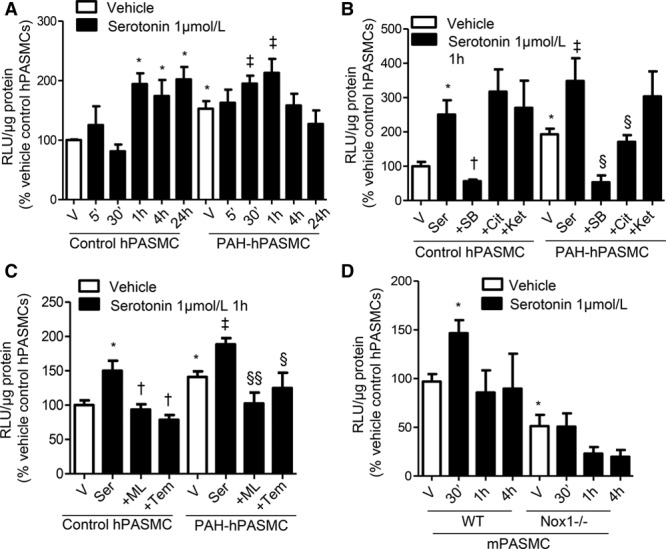Figure 1.

Serotonin increases reactive oxygen species (ROS) production through Nox-dependent mechanisms. Time-dependent increase of ROS production by serotonin (1 µmol/L) in control human pulmonary artery smooth muscle cells (hPASMCs) and pulmonary arterial hypertension (PAH)-hPASMCs assessed by lucigenin-enhanced chemiluminescence (A). hPASMCs and human pulmonary artery smooth muscle cells from PAH subjects (PAH-hPASMCs) were exposed to serotonin for the time of peak ROS production (1 h) previously shown in (A), in the presence or absence of inhibitors of Nox1 (ML171, 1 µmol/L) and superoxide dismutase mimetic Tempol (10 µmol/L; B). Serotonin-induced ROS production in wild-type (WT) and Nox1−/− mouse pulmonary artery smooth muscle cells (mPASMCs; C). ROS production by serotonin (1 µmol/L) in control hPASMCs and PAH-hPASMCs at 1 h stimulation, in the presence or absence of 5-HT1BR antagonist, SB224289, SERT inhibitor, citalopram (Cit), or 5-HT2A/1DR antagonist (D). Data are expressed as relative light units (RLU)/µg protein, expressed as percentage of vehicle control conditions. Results are mean±SEM of 5 experiments, in triplicate. *P<0.05 vs vehicle control hPASMC or vehicle WT mPASMCs; †P<0.05 vs treated control hPASMC; ‡P<0.05 vs vehicle PAH-hPASMCs; §P<0.05, §§P<0.01 vs treated PAH-hPASMCs determined by ANOVA with Tukey post hoc test. Ket indicates ketanserin; ML, ML171; SB, SB224289; Ser, serotonin; Tem, Tempol; and V, vehicle.
